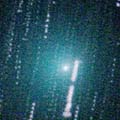
|
Recovered after 117 year blank since 1889. This time it will be closer to the earth than at the discovery, and observable in good condition. It has been getting brighter and larger very rapidly since mid July. It is so bright as 8.4 mag still now, with a diameter of 8 arcmin or larger (Aug. 21, Juan Jose Gonzalez). In the Northern Hemisphere, it keeps locating very high in the evening sky until winter when it becomes too faint. It will be bright visually until September, but it will fade out rapidly after October.
Date(TT) R.A. (2000) Decl. Delta r Elong. m1 Best Time(A, h)
Aug. 26 16 58.87 53 26.6 0.500 1.108 87 8.6 19:00 (177, 1)
Sept. 2 17 7.07 58 7.1 0.532 1.109 86 8.8 19:05 (174, -4)
|
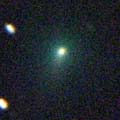
|
New comet discovered on the SWAN images. It was observed in the Southern Hemisphere in July, but now it is not observable. It was very bright as 9.6 mag visually on July 20 (David Seargent). It was about 10.0 mag in SOHO LASCO images on Aug. 15, almost bright as expected. In the Northern Hemisphere, it will appear at 7.5 mag in the extremely low sky at dawn in late September. It will turn to locate in the evening sky after early October. Then it keeps observable in the evening sky until early January while fading gradually. In the Southern Hemisphere, it cannot be observable until next April when it becomes fainter than 15 mag.
Date(TT) R.A. (2000) Decl. Delta r Elong. m1 Best Time(A, h)
Aug. 26 10 10.58 14 11.0 2.016 1.011 4 9.6 5:03 (265,-18)
Sept. 2 10 24.56 17 12.5 1.910 0.935 10 9.1 4:54 (262,-19)
|
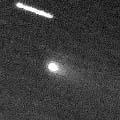
|
It is brightening as expected, and it is already visible visually. Now it is 11.7 mag (Aug. 22, Seiichi Yoshida). It will be brightening rapidly after this, and will reach to 9 mag from autumn to winter, and observable in its best condition. It keeps 14 mag still in 2007 March, so it keeps visible visually for a long time.
Date(TT) R.A. (2000) Decl. Delta r Elong. m1 Best Time(A, h)
Aug. 26 1 35.86 15 14.0 1.079 1.851 124 11.2 3:20 (180, 40)
Sept. 2 1 43.75 15 18.1 1.005 1.823 129 10.9 3:00 (180, 40)
|

|
It reached up to 10.3 mag on July 7 (Juan Jose Gonzalez). Then it is fading gradually. Now it is 13.0 mag (Aug. 21, Jose Carvajal). It keeps very low, only about 15 degree high until September in the Northern Hemisphere. When it gets higher again, it will be fainter than 14 mag, too faint to see visually.
Date(TT) R.A. (2000) Decl. Delta r Elong. m1 Best Time(A, h)
Aug. 26 19 48.17 -40 3.3 0.867 1.739 135 12.3 21:30 ( 0, 85)
Sept. 2 19 54.58 -38 59.2 0.933 1.769 131 12.6 21:09 ( 0, 86)
|

|
It is bright as 12.6 mag and visible visually (June 21, Juan Jose Gonzalez). In the Northern Hemisphere, it locates rather low in the evening. It will be too low at dusk to observe in October. But it will be getting higher in the morning sky after December. It keeps 13 mag until 2007 March, so it will be visible visually for a long time.
Date(TT) R.A. (2000) Decl. Delta r Elong. m1 Best Time(A, h)
Aug. 26 14 17.36 -5 44.8 2.543 2.249 61 13.0 19:00 (114, 39)
Sept. 2 14 21.91 -4 4.1 2.615 2.211 55 13.0 19:05 (110, 33)
|
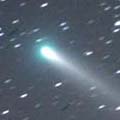
|
It reached to 6 mag at best in early May at the remarkable approach to the earth, when it became double naked eye comets with the component B around the zenith. Now it is going away from the earth and fading. It has already faded down to 13.0 mag (Aug. 22, Seiichi Yoshida). It will be too faint to see visually soon. The component B has faded out rapidly since June, and already so faint, fainter than 17 mag.
Date(TT) R.A. (2000) Decl. Delta r Elong. m1 Best Time(A, h)
Aug. 26 2 12.85 -15 4.2 0.627 1.449 122 13.4 3:57 (180, 70)
Sept. 2 2 3.20 -15 48.0 0.649 1.515 130 13.8 3:20 (180, 71)
|

|
Since it appeared in the morning sky in early July, it has been bright as 12-13 mag and visible visually. It is 13.2 mag still now (Aug. 22, Seiichi Yoshida). It is observable in good condition until winter.
Date(TT) R.A. (2000) Decl. Delta r Elong. m1 Best Time(A, h)
Aug. 26 4 19.42 30 36.0 5.846 5.834 84 13.6 5:03 (194, 23)
Sept. 2 4 21.71 30 50.2 5.738 5.835 90 13.5 4:54 (190, 23)
|

|
It had been observed at 10 mag in the evening sky from winter to spring. Although it has been unobservable since May, now it is appearing in the morning sky again. It will come to locate high in October, then it will be visible visually again at 14 mag.
Date(TT) R.A. (2000) Decl. Delta r Elong. m1 Best Time(A, h)
Aug. 26 8 39.31 29 21.2 3.657 2.824 29 13.7 5:03 (240, -9)
Sept. 2 8 50.37 28 40.7 3.678 2.893 33 13.8 4:54 (240, -7)
|

|
It has been visible at 13.5 mag for a long time since last autumn until spring. But it is already very low in the evening sky. It will be too low to observe soon. However, it will be observable in good condition again at 14.5 mag in next winter.
Date(TT) R.A. (2000) Decl. Delta r Elong. m1 Best Time(A, h)
Aug. 26 11 23.18 31 21.3 6.186 5.293 25 14.3 19:00 (117,-16)
Sept. 2 11 30.32 30 27.6 6.202 5.304 24 14.3 19:05 (113,-21)
|

|
Although it had been asteroidal for about one year since 2005 July, the cometary activity was detected in late July in 2006. But actually, it is almost stellar now. In the Northern Hemisphere, it keeps good condition after this. It keeps locating high until next spring. Now it is 15.5 mag and completely stellar visually (Aug. 22, Seiichi Yoshida). The light curve had been completely asteroidal so far. However, it can brighten rapidly as a comet after this, and it may reach to 11 mag in winter.
Date(TT) R.A. (2000) Decl. Delta r Elong. m1 Best Time(A, h)
Aug. 26 22 12.65 21 36.8 1.181 2.106 147 14.6 23:53 (180, 33)
Sept. 2 22 0.13 23 36.0 1.119 2.039 146 14.3 23:12 (180, 31)
|

|
It has been lost since its discovery in 1986. The condition is good in this return. In calculation, it will be 14 mag from autumn to winter. However, it was probably in outburst and brightened unexpectedly at the discovery. So it can be much fainer than this ephemeris actually. In the Northern Hemisphere, it keeps observable until it fades out in next spring.
Date(TT) R.A. (2000) Decl. Delta r Elong. m1 Best Time(A, h)
Aug. 26 17 30.59 -22 31.3 1.069 1.710 110 14.6 19:13 (180, 78)
Sept. 2 17 37.38 -22 28.9 1.088 1.670 105 14.5 19:05 (167, 77)
|

|
It is bright as 13.7 mag and visible visually (Aug. 22, Seiichi Yoshida). It keeps locating at the same altitude until December. But it will be too faint to see visually in October.
Date(TT) R.A. (2000) Decl. Delta r Elong. m1 Best Time(A, h)
Aug. 26 22 28.84 -23 2.6 2.276 3.269 167 14.6 0:14 (180, 78)
Sept. 2 22 24.01 -23 23.1 2.300 3.282 163 14.7 23:37 (180, 78)
|
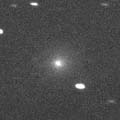
|
The condition is worst in this time, not visible in the Northern Hemisphere at all. It was observed in the Southern Hemisphere as 11.4 mag on June 6, as bright as expected (Michael Mattiazzo). However, in this appearance, the comet will never be observable again.
Date(TT) R.A. (2000) Decl. Delta r Elong. m1 Best Time(A, h)
Aug. 26 10 33.63 11 23.5 2.202 1.196 3 14.9 19:00 ( 93,-15)
Sept. 2 10 54.75 9 25.6 2.299 1.293 3 15.5 19:05 ( 90,-16)
|

|
It was in major outburst unexpectedly and reached to 10.5 mag in its last appearance in 1999. It was already recovered in 2005 October. But it has not been observed for about 1 year since that. So the current brightness is quite uncertain. It will appear in the morning sky at 15.5 mag in September, then it will fade out gradually. But actually, it can be much fainter than this ephemeris.
Date(TT) R.A. (2000) Decl. Delta r Elong. m1 Best Time(A, h)
Aug. 26 9 8.37 20 27.2 2.681 1.760 19 15.3 5:03 (252, -9)
Sept. 2 9 26.95 18 43.3 2.666 1.766 21 15.3 4:54 (253, -8)
|
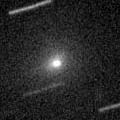
|
It brightened much more rapidly than expected after late April, and reached to 9.5 mag on June 15 (Willian Souza). Then it has been fading very rapidly. It has already faded down to 13.3 mag (Aug. 20, Jakub Cerny), and it will be too faint to see visually soon. CCD observers reported that it has already fainter than 16 mag. Although it keeps higher than 20 deg in the evening sky until November, it may be too faint to observe soon.
Date(TT) R.A. (2000) Decl. Delta r Elong. m1 Best Time(A, h)
Aug. 26 15 21.46 -10 27.4 1.242 1.433 78 15.5 19:00 (126, 54)
Sept. 2 15 46.46 -12 44.2 1.326 1.491 78 16.4 19:05 (121, 55)
|

|
It was observed as 12 mag in spring. It was diffuse visually, but bright and enjoyable with a large telescope. However, it has already faded down to 16.2 mag (Aug. 14, Mitsunori Tsumura). It keeps observable in good condition until autumn. It will be very low in November, but it will be getting higher in the morning sky after that. So it keeps observable for a long time until it becomes too faint.
Date(TT) R.A. (2000) Decl. Delta r Elong. m1 Best Time(A, h)
Aug. 26 15 18.78 28 3.4 3.135 2.983 72 15.6 19:00 (152, 21)
Sept. 2 15 19.64 27 31.1 3.287 3.050 67 15.8 19:05 (145, 18)
|

|
It is outside of Jupiter's orbit, so it keeps observable for a long time. In 2006, it is still faint and locating somewhat low. But in 2007 and 2008, it is expected to be bright as 14.5-15 mag. It will locate high at that time, so it may be visible visually.
Date(TT) R.A. (2000) Decl. Delta r Elong. m1 Best Time(A, h)
Aug. 26 18 53.46 -23 5.4 5.980 6.671 129 15.7 20:35 (180, 78)
Sept. 2 18 48.49 -22 48.9 6.057 6.645 121 15.7 20:02 (180, 78)
|

|
Appearing at dawn. It will be observable at 15.5 mag for a long time from September to January.
Date(TT) R.A. (2000) Decl. Delta r Elong. m1 Best Time(A, h)
Aug. 26 6 57.44 27 12.8 2.038 1.588 49 16.1 5:03 (227, 9)
Sept. 2 7 18.96 25 41.2 1.996 1.582 51 16.0 4:54 (229, 10)
|

|
It is observable in good condition at 15 mag in September and October.
Date(TT) R.A. (2000) Decl. Delta r Elong. m1 Best Time(A, h)
Aug. 26 9 17.58 38 50.7 0.596 0.590 31 16.7 5:03 (237,-21)
Sept. 2 8 56.08 48 29.7 0.558 0.743 46 16.1 4:54 (224,-19)
|

|
It keeps observable at 17 mag in good condition until October.
Date(TT) R.A. (2000) Decl. Delta r Elong. m1 Best Time(A, h)
Aug. 26 23 49.26 -6 39.8 1.593 2.554 157 16.8 1:34 (180, 62)
Sept. 2 23 44.45 -6 27.7 1.588 2.576 164 16.8 1:02 (180, 61)
|

|
It will pass only 0.17 A.U. from the sun in 2007 January. Now it is still faint as 17 mag. However, it may be already so bright as 14 mag (Aug. 21, Terry Lovejoy). The comet will be brightening gradually after this, but it keeps locating low in the evening in the Northern Hemisphere. It is not observable when it becomes brightest. After the perihelion passage, it is only observable in the Southern Hemisphere.
Date(TT) R.A. (2000) Decl. Delta r Elong. m1 Best Time(A, h)
Aug. 26 16 25.16 -16 39.7 2.518 2.789 94 17.0 19:00 (144, 68)
Sept. 2 16 22.39 -16 13.1 2.542 2.690 87 16.8 19:05 (128, 63)
|

|
It was 16.0 mag on Mar. 13 (Ken-ichi Kadota). It kept 16-16.5 mag for about one year from early 2005. It keeps 17 mag until autumn.
Date(TT) R.A. (2000) Decl. Delta r Elong. m1 Best Time(A, h)
Aug. 26 0 45.37 51 58.5 3.178 3.648 109 16.9 2:30 (180, 3)
Sept. 2 0 37.45 50 51.9 3.122 3.679 116 16.9 1:55 (180, 4)
|

|
It was observed at 17 mag in spring. It will be observable in good condition at 17 mag again in autumn. It will be fainter than 18 mag in December.
Date(TT) R.A. (2000) Decl. Delta r Elong. m1 Best Time(A, h)
Aug. 26 6 24.14 26 13.0 2.229 1.883 57 17.0 5:03 (222, 15)
Sept. 2 6 18.45 24 35.5 2.109 1.918 65 16.9 4:54 (218, 19)
|
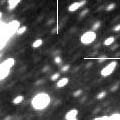
|
It keeps 17 mag for a long time after this until the end of 2007. It will be observable in good condition in 2006 autumn and 2007 autumn.
Date(TT) R.A. (2000) Decl. Delta r Elong. m1 Best Time(A, h)
Aug. 26 19 24.47 47 52.5 3.410 3.875 110 17.0 21:06 (180, 7)
Sept. 2 19 22.95 47 14.6 3.400 3.851 109 17.0 20:37 (180, 8)
|

|
It was 19.3 mag on Aug. 23 (Luca Buzzi), fainter than this ephemeris by 1.5 mag. It will brighten rapidly after this. The condition of this apparition is excellent. It is expected to reach to 15.5 mag in October and November. But actually, it may be fainter than expected.
Date(TT) R.A. (2000) Decl. Delta r Elong. m1 Best Time(A, h)
Aug. 26 3 27.42 5 53.5 1.084 1.620 101 17.3 5:03 (183, 49)
Sept. 2 3 40.45 8 34.8 1.006 1.590 104 17.0 4:54 (181, 46)
|
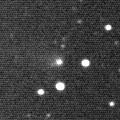
|
It was bright as 15 mag in 2004 and 2005. Now it is far away from the sun, but it still observable at 17 mag in 2006.
Date(TT) R.A. (2000) Decl. Delta r Elong. m1 Best Time(A, h)
Aug. 26 1 12.68 -13 34.7 3.209 4.010 137 17.1 2:57 (180, 69)
Sept. 2 1 10.11 -14 8.7 3.171 4.027 143 17.1 2:27 (180, 69)
|

|
It was observed at 17 mag in 2005 summer. It will reach to 17 mag again in 2006 summer.
Date(TT) R.A. (2000) Decl. Delta r Elong. m1 Best Time(A, h)
Aug. 26 22 39.23 -12 4.0 2.325 3.333 174 17.1 0:24 (180, 67)
Sept. 2 22 34.94 -12 43.2 2.336 3.342 174 17.1 23:48 (180, 68)
|

|
It will be observable at 17 mag in good condition in September and October. Then it will fade out rapidly, and will be fainter than 18 mag in December.
Date(TT) R.A. (2000) Decl. Delta r Elong. m1 Best Time(A, h)
Aug. 26 3 14.16 17 59.3 2.134 2.538 101 17.2 4:58 (180, 37)
Sept. 2 3 18.30 17 26.1 2.073 2.565 107 17.2 4:35 (180, 38)
|

|
It was 17.6 mag on July 23 (Filip Fratev). It will brighten after the perihelion passage. It will reach to 15.5 mag and will be observable in good condition from November to January.
Date(TT) R.A. (2000) Decl. Delta r Elong. m1 Best Time(A, h)
Aug. 26 4 40.49 14 27.2 1.707 1.859 82 17.5 5:03 (205, 37)
Sept. 2 4 54.28 14 43.8 1.652 1.866 85 17.3 4:54 (203, 37)
|

|
It reached to 6 mag in 2004. It had been visible visually until January. It is appearing at dawn after a blank of half a year. It will be already very faint as 17 mag. It will be fading slowly around 17-18 mag until December.
Date(TT) R.A. (2000) Decl. Delta r Elong. m1 Best Time(A, h)
Aug. 26 3 7.25 -1 25.6 7.262 7.630 107 17.3 4:51 (180, 56)
Sept. 2 3 5.28 -1 43.9 7.212 7.687 114 17.3 4:22 (180, 57)
|

|
It was observed at 18.5 mag on Aug. 27, as bright as expected (Luca Buzzi). It will brighten very rapidly in the morning sky after this. It will reach to 13.5 mag in November and December, and will be observable in an excellent condition.
Date(TT) R.A. (2000) Decl. Delta r Elong. m1 Best Time(A, h)
Aug. 26 5 11.14 0 9.5 1.746 1.809 76 17.8 5:03 (223, 46)
Sept. 2 5 25.89 1 2.8 1.663 1.779 79 17.4 4:54 (221, 46)
|
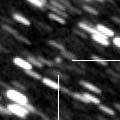
|
It will reach to 14.5 mag in 2007 summer, but it will be observable only in the Southern Hemisphere at that time. In the Northern Hemisphere, it keeps observable at 17.5 mag in good condition until autumn.
Date(TT) R.A. (2000) Decl. Delta r Elong. m1 Best Time(A, h)
Aug. 26 19 44.53 5 59.2 4.467 5.265 138 17.5 21:25 (180, 49)
Sept. 2 19 39.34 4 38.6 4.486 5.219 132 17.4 20:53 (180, 50)
|

|
It was observed at 17 mag in late 2005. In 2006, it will be observable at 17.5 mag in autumn.
Date(TT) R.A. (2000) Decl. Delta r Elong. m1 Best Time(A, h)
Aug. 26 2 55.78 24 38.5 5.015 5.346 103 17.6 4:40 (180, 30)
Sept. 2 2 49.95 24 39.5 4.903 5.358 111 17.5 4:07 (180, 30)
|
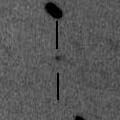
|
The perihelion passage is in 2008. It will be observable for several years after this at around 17 mag. But it may fade out rapidly just after the perihelion passage.
Date(TT) R.A. (2000) Decl. Delta r Elong. m1 Best Time(A, h)
Aug. 26 4 44.77 11 16.3 4.971 4.924 81 17.9 5:03 (208, 39)
Sept. 2 4 47.95 11 16.4 4.853 4.911 87 17.8 4:54 (203, 41)
|

|
It will reach to 17 mag in autumn and winter.
Date(TT) R.A. (2000) Decl. Delta r Elong. m1 Best Time(A, h)
Aug. 26 4 27.98 41 55.2 3.976 3.949 81 18.0 5:03 (193, 11)
Sept. 2 4 33.89 42 51.2 3.873 3.939 86 17.9 4:54 (190, 11)
|
|
![]()
 117P/Helin-Roman-Alu 1
117P/Helin-Roman-Alu 1 45P/Honda-Mrkos-Pajdusakova
45P/Honda-Mrkos-Pajdusakova 52P/Harrington-Abell
52P/Harrington-Abell 41P/Tuttle-Giacobini-Kresak
41P/Tuttle-Giacobini-Kresak C/2004 B1 ( LINEAR )
C/2004 B1 ( LINEAR ) C/2005 L3 ( McNaught )
C/2005 L3 ( McNaught ) 114P/Wiseman-Skiff
114P/Wiseman-Skiff (3200) Phaethon
(3200) Phaethon P/2006 H1 ( McNaught )
P/2006 H1 ( McNaught ) C/2006 P1 ( McNaught )
C/2006 P1 ( McNaught ) C/2005 B1 ( Christensen )
C/2005 B1 ( Christensen ) C/2006 CK10 ( Catalina )
C/2006 CK10 ( Catalina ) C/2006 M1 ( LINEAR )
C/2006 M1 ( LINEAR ) 112P/Urata-Niijima
112P/Urata-Niijima P/2004 F3 ( NEAT )
P/2004 F3 ( NEAT ) P/2005 L1 ( McNaught )
P/2005 L1 ( McNaught ) P/2005 JY126 ( Catalina )
P/2005 JY126 ( Catalina ) 84P/Giclas
84P/Giclas C/2003 K4 ( LINEAR )
C/2003 K4 ( LINEAR ) 76P/West-Kohoutek-Ikemura
76P/West-Kohoutek-Ikemura C/2006 K4 ( NEAT )
C/2006 K4 ( NEAT ) C/2005 R4 ( LINEAR )
C/2005 R4 ( LINEAR ) 173P/2005 T1 ( Mueller 5 )
173P/2005 T1 ( Mueller 5 ) P/2005 SB216 ( LONEOS )
P/2005 SB216 ( LONEOS )![]()




















